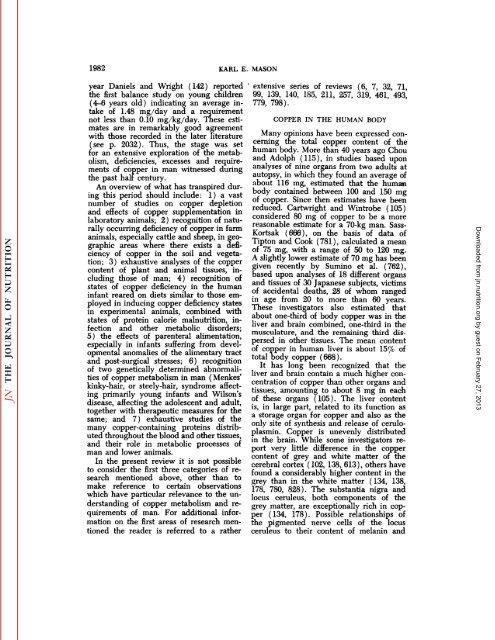conspectus of researchon copper metabolism and requirements
conspectus of researchon copper metabolism and requirements
conspectus of researchon copper metabolism and requirements
You also want an ePaper? Increase the reach of your titles
YUMPU automatically turns print PDFs into web optimized ePapers that Google loves.
1982 KARL E. MASON<br />
year Daniels <strong>and</strong> Wright (142) reported<br />
the first balance study on young children<br />
(4-6 years old) indicating an average in<br />
take <strong>of</strong> 1.48 mg/day <strong>and</strong> a requirement<br />
not less than 0.10 mg/kg/day. These esti<br />
mates are in remarkably good agreement<br />
with those recorded in the later literature<br />
(see p. 2032). Thus, the stage was set<br />
for an extensive exploration <strong>of</strong> the metab<br />
olism, deficiencies, excesses <strong>and</strong> require<br />
ments <strong>of</strong> <strong>copper</strong> in man witnessed during<br />
the past half century.<br />
An overview <strong>of</strong> what has transpired dur<br />
ing this period should include: 1) a vast<br />
number <strong>of</strong> studies on <strong>copper</strong> depletion<br />
<strong>and</strong> effects <strong>of</strong> <strong>copper</strong> supplementation in<br />
laboratory animals; 2) recognition <strong>of</strong> natu<br />
rally occurring deficiency <strong>of</strong> <strong>copper</strong> in farm<br />
animals, especially cattle <strong>and</strong> sheep, in geo<br />
graphic areas where there exists a defi<br />
ciency <strong>of</strong> <strong>copper</strong> in the soil <strong>and</strong> vegeta<br />
tion; 3) exhaustive analyses <strong>of</strong> the <strong>copper</strong><br />
content <strong>of</strong> plant <strong>and</strong> animal tissues, in<br />
cluding those <strong>of</strong> man; 4) recognition <strong>of</strong><br />
states <strong>of</strong> <strong>copper</strong> deficiency in the human<br />
infant reared on diets similar to those em<br />
ployed in inducing <strong>copper</strong> deficiency states<br />
in experimental animals, combined with<br />
states <strong>of</strong> protein calorie malnutrition, in<br />
fection <strong>and</strong> other metabolic disorders;<br />
5) the effects <strong>of</strong> parenteral alimentation,<br />
especially in infants suffering from devel<br />
opmental anomalies <strong>of</strong> the alimentary tract<br />
<strong>and</strong> post-surgical stresses; 6) recognition<br />
<strong>of</strong> two genetically determined abnormali<br />
ties <strong>of</strong> <strong>copper</strong> <strong>metabolism</strong> in man ( Menkes'<br />
kinky-hair, or steely-hair, syndrome affect<br />
ing primarily young infants <strong>and</strong> Wilson's<br />
disease, affecting the adolescent <strong>and</strong> adult,<br />
together with therapeutic measures for the<br />
same; <strong>and</strong> 7) exhaustive studies <strong>of</strong> the<br />
many <strong>copper</strong>-containing proteins distrib<br />
uted throughout the blood <strong>and</strong> other tissues,<br />
<strong>and</strong> their role in metabolic processes <strong>of</strong><br />
man <strong>and</strong> lower animals.<br />
In the present review it is not possible<br />
to consider the first three categories <strong>of</strong> re<br />
search mentioned above, other than to<br />
make reference to certain observations<br />
which have particular relevance to the un<br />
derst<strong>and</strong>ing <strong>of</strong> <strong>copper</strong> <strong>metabolism</strong> <strong>and</strong> re<br />
quirements <strong>of</strong> man. For additional infor<br />
mation on the first areas <strong>of</strong> research men<br />
tioned the reader is referred to a rather<br />
extensive series <strong>of</strong> reviews (6, 7, 32, 71,<br />
99, 139, 140, 185, 211, 257, 319, 461, 493,<br />
779, 798).<br />
COPPER IN THE HUMAN BODY<br />
Many opinions have been expressed con<br />
cerning the total <strong>copper</strong> content <strong>of</strong> the<br />
human body. More than 40 years ago Chou<br />
<strong>and</strong> Adolph (115), in studies based upon<br />
analyses <strong>of</strong> nine organs from two adults at<br />
autopsy, in which they found an average <strong>of</strong><br />
about 116 mg, estimated that the human<br />
body contained between 100 <strong>and</strong> 150 mg<br />
<strong>of</strong> <strong>copper</strong>. Since then estimates have been<br />
reduced. Cartwright <strong>and</strong> Wintrobe (105)<br />
considered 80 mg <strong>of</strong> <strong>copper</strong> to be a more<br />
reasonable estimate for a 70-kg man. Sass-<br />
Kortsak (666), on the basis <strong>of</strong> data <strong>of</strong><br />
Tipton <strong>and</strong> Cook (781), calculated a mean<br />
<strong>of</strong> 75 mg, with a range <strong>of</strong> 50 to 120 mg.<br />
A slightly lower estimate <strong>of</strong> 70 mg has been<br />
given recently by Sumino et al. (762),<br />
based upon analyses <strong>of</strong> 18 different organs<br />
<strong>and</strong> tissues <strong>of</strong> 30 Japanese subjects, victims<br />
<strong>of</strong> accidental deaths, 28 <strong>of</strong> whom ranged<br />
in age from 20 to more than 60 years.<br />
These investigators also estimated that<br />
about one-third <strong>of</strong> body <strong>copper</strong> was in the<br />
liver <strong>and</strong> brain combined, one-third in the<br />
musculature, <strong>and</strong> the remaining third dis<br />
persed in other tissues. The mean content<br />
<strong>of</strong> <strong>copper</strong> in human liver is about \5% <strong>of</strong><br />
total body <strong>copper</strong> (668).<br />
It has long been recognized that the<br />
liver <strong>and</strong> brain contain a much higher con<br />
centration <strong>of</strong> <strong>copper</strong> than other organs <strong>and</strong><br />
tissues, amounting to about 8 mg in each<br />
<strong>of</strong> these organs ( 105). The liver content<br />
is, in large part, related to its function as<br />
a storage organ for <strong>copper</strong> <strong>and</strong> also as the<br />
only site <strong>of</strong> synthesis <strong>and</strong> release <strong>of</strong> ceruloplasmin.<br />
Copper is unevenly distributed<br />
in the brain. While some investigators re<br />
port very little difference in the <strong>copper</strong><br />
content <strong>of</strong> grey <strong>and</strong> white matter <strong>of</strong> the<br />
cerebral cortex (102, 138, 613), others have<br />
found a considerably higher content in the<br />
grey than in the white matter ( 134, 138,<br />
178, 780, 828). The substantia nigra <strong>and</strong><br />
locus ceruleus, both components <strong>of</strong> the<br />
grey matter, are exceptionally rich in cop<br />
per ( 134, 178). Possible relationships <strong>of</strong><br />
the pigmented nerve cells <strong>of</strong> the locus<br />
ceruleus to their content <strong>of</strong> melanin <strong>and</strong><br />
Downloaded from<br />
jn.nutrition.org<br />
by guest on February 27, 2013
















